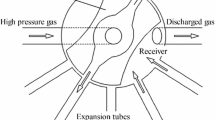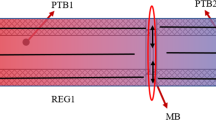Abstract
The pulse tube refrigerator (PTR) is a promising small-scale cryocooler. This paper first briefly introduces the history of the pulse tube refrigerator. It has pointed out that technology improvements and theoretical developments of the pulse tube refrigerator closely relate with the internal streaming effects. Then the discovering history and classification of the streaming or DC (direct current) flow effect are summarized. It proposes for the first time that the physical significance of the streaming contains the driving mechanisms and the transport mechanisms. It demonstrates that the driving mechanisms are the asymmetry of fluid flow and temperature while the transport mechanisms are a loop or vorticity, which transmits nonlinear dissipations. The important advancements have been made over the past two decades all over the world in research of streaming of the pulse tube refrigerator including Gedeon DC flow, Rayleigh streaming, the third type of DC flow and the regenerator circulation. With regard to Gedeon DC flow, theoretical and experimental analyses have been made and different suppression methods are summarized. In the aspect of Rayleigh streaming, it mainly focuses on the analytical solution of the second-order mass flow and the research of tapered pulse tubes. In particular, limited research on the third type of DC flow and regenerator circulation is presented. The experimental measurement techniques of streaming also are summarized. Finally, this paper briefly discusses the key scientific and technical issues of the current research, and foretells the future development trends of streaming research in PTR.
Similar content being viewed by others
References
Radebaugh R. A review of pulse tube refrigeration. Adv Cryogenic Eng, 1990, 35: 1191–1205
Radebaugh R. Cryocoolers: the state of the art and recent developments. J Phys: Conden Matter, 2009, 21: 4219–4228
Mikulin E I, Tarasov A A, Shkrebyonock M P. Low temperature expansion pulse tubes. Adv Cryogen Eng, 1984, 29: 629–637
Liang J T, Zhou Y, Zhu W X. Development of a single-stage pulse tube refrigerator capable of reaching 49 K. Cryogenics, 1990, 30: 49–51
Zhu S W, Wu P Y, Chen Z Q. Double inlet pulse tube refrigerators: an important improvement. Cryogenics, 1990, 30: 514–520
Kanao K, Watanabe N, Kanazawa Y. A miniature pulse tube refrigerator for temperatures below 100K. Cryogenics, 1994, 34(Suppl): 167–170
Backhaus S, Swift G W. A thermoacoustic-Stirling heat engine. Nature, 1999, 399: 335–338
Seki N, Yamasaki S, Yuyama J, et al. Temperature Stability of Pulse Tube Refrigerators. Proceedings of the 16th International Cryogenic Engineering Conference, Japan, 1996
Gedeon D. DC gas flows in Stirling and pulse tube cryocoolers. Cryocoolers, 1996, 9: 385–392
Swift G W. Thermoacoustics: A unifying perspective for some engines and refrigerators. Los Alamos: Acoustical Society of America, 1999
Olson J R, Swift G W. Acoustic streaming in pulse tube refrigerators: Tapered pulse tubes. Cryogenics, 1997, 37: 769–776
Rayleigh L. On the circulation of air observed in Kundt’s tubes, and on some allied acoustical problems. Philos Trans Roy Soc London Ser A, 1883, 175: 1–21
Mironov M, Gusev V, Auregan Y, et al. Acoustic streaming related to minor loss phenomenon in differentially heated elements of thermoacoustic devices. J Acoust Soc Amer, 2002, 112: 441–445
Liang W, De Waele. A new type of streaming in pulse tubes. Cryogenics, 2007, 47: 468–473
Zhou Y, Gu C, Cai H K. The third type DC flow in pulse tube cryocooler. Sci China Ser E-Tech Sci, 2009, 52: 3491–3496
Gu C, Zhou Y, Wang J J, et al. Experimental discovery and verification of the third type of DC gas flow in pulse tube cryocooler. Cryogenics, 2011, 51: 157–160
Gu C, Zhou Y, Wang J J, et al. CFD analysis of nonlinear processes in pulse tube refrigerators: Streaming induced by vortices. Int J Heat Mass Transfer, 2012, 55: 7410–7418
Dietrich M, Yang L W, Thummes G. High-power Stirling-type pulse tube cryocooler: Observation and reduction of regenerator temperature-inhomogeneities. Cryogenics, 2007, 47: 306–314
Landau L D, Lifshitz E M. Fluid Mechanics. New York: Pergamon Press, 1987
Boluriaan S, Morris J. Acoustic streaming: from Rayleigh to today. Int J Aeroacoust, 2003, 2: 255–292
Sobey I. Observation of waves during oscillatory channel flow. J Fluid Mech, 1985, 151: 395–426
Ju Y L, Wang C, Zhou Y. Dynamic experimental investigation of a multi-bypass pulse tube refrigerator. Cryogenics, 1997, 37: 357–361
Ju Y L, Wang C, Zhou Y. Dynamic experimental investigation of a multi-bypass pulse tube refrigerator (in Chinese). J Eng Thermophys, 1997, 18: 413–416
Charles I, Duband L, Ravex A. Permanent flow in low and high frequency pulse tube coolers-Experimental results. Cryogenics, 1999, 39:777–782
Backhaus S, Swift G W. A thermoacoustic-Stirling heat engine: Detailed study. J Acoust Soc Am, 2000, 107: 3148–3166
Wang C, Thummes G, Heiden C. Control of DC gas flow in a single-stage double-inlet pulse tube cooler. Cryogenics, 1998, 38: 843–847
Wang C, Thummes G, Heiden C. Effects of DC gas flow on performance of two-stage 4 K pulse tube coolers. Cryogenics, 1998, 38: 689–695
Liang J T, Zhou Y, Zhu W X, et al. Study on miniature pulse tube cryocooler for space application. Cryogenics, 2000, 40: 229–233
Chen G, Qui L, Zheng J, et al. Experimental study on a double-orifice two-stage pulse tube refrigerator. Cryogenics, 1997, 37: 271–273
Yang L W, Zhou Y, Liang J T. DC flow analysis and second orifice version pulse tube refrigerator. Cryogenics, 1999, 39: 187–192
Shiraishi M, Takamatsu K, Murakami M. Visualization of DC gas flows in a double-inlet pulse tube refrigerator with a second orifice valve. Cryocoolers, 2002, 11: 371–379
Hu J Y, Luo E C, Wu Z H, et al. Investigation of an innovative method for DC flow suppression of double-inlet pulse tube coolers. Cryogenics, 2007, 47: 287–291
Swift G W, Gardner D L, Backhaus S. Acoustic recovery of lost power in pulse tube refrigerators. J Acoust Soc Am, 1999, 105: 711–724
Zhu S W, Nogawa M, Inoue T. Analysis of DC gas flow in GM type double inlet pulse tube refrigerators. Cryogenics, 2009, 49: 66–71
Rott N. Thermal driven acoustic oscillations, Part 3: Second order heat flux. Z Angew Math Phys, 1975, 26: 43–49
Lee J M, Kittel P, Timmerhaus K D, et al. Flow patterns intrinsic to the pulse tube refrigerator. Proceedings of the 7th International Cryocooler Conference, Santa Fe, 1992. 125-139
Lee J M, Kittel P, Timmerhaus K D, et al. Steady secondary momentum and enthalpy streaming in the pulse tube refrigerator. Cryocoolers, 1995, 8: 359–369
Sang H B, Eun S J, Sangkwon J. Two-dimensional model for tapered pulse tubes. Part 2: Mass streaming and streaming-driven enthalpy flow loss. Cryogenics, 2000, 40: 387–392
Shiraishi M, Ikeguchi T, Murakami M. Visualization of oscillatory flow phenomena in tapered pulse tube refrigerators. Adv Cryogen Eng, 2002, 47: 768–775
He Y L, Gao C M, Xu M Y, et al. Numerical simulation of conver gent and divergent tapered pulse tube cryocoolers and experimental verification. Cryogenics, 2001, 41: 699–704
He Y L, Zhao C F, Ding W J, et al. Two-dimensional numerical simulation and performance analysis of tapered pulse tube refrigerator. Appl Therm Eng, 2007, 27: 1876–1882
Antao D S, Farouk B. Numerical simulations of transport processes in a pulse tube cryocooler: Effects of taper angle. Int J Heat Mass Transfer, 2011, 54: 4611–4620
Antao D S, Farouk B. Computational fluid dynamics simulations of an orifice type pulse tube refrigerator: Effects of operating frequency. Cryogenics, 2011, 51: 192–201
Cha J S, Ghiaasiaan S M, Desai P V, et al. Multi-dimensional flow effects in pulse tube refrigerators. Cryogenics, 2006, 46: 658–665
Gu C, Jin H, Zhou Y, et al. A novel Stirling type pulse tube cryocooler suppressing the third type of dc gas flow. Adv Cryogen Eng, 2012, 57: 214–220
So J H, Swift G W, Backhaus S. An internal streaming instability in regenerators. J Acoust Soc Am, 2006, 120: 1898–1909
Sun D M, Dietrich M, Thummes G. Study on temperature inhomogeneity in regenerator of Stirling-type pulse tube cryocoolers. Chin Sci Bull, 2008, 53: 3062–3066
Andersen S K, Dietrich M, Carlsen H. Numerical study on transverse asymmetry in the temperature profile of a regenerator in a pulse tube cooler. Int J Heat Mass Transfer, 2007, 50: 2795–2804
Liu D H, Qiu L M, Gan Z H, et al. Study on temperature inhomogeneity in regenerator of high-power Stirling-type pulse tube cryocoolers based on two parallel regenerator model (in Chinese). Cryogenics, 2011, 6: 1–5
Imura J, Iwata N, Yamamoto H. Optimization of regenerator in high capacity Stirling type pulse tube cryocooler. Physica C, 2008, 468: 2178–2180
Garaway I, Taylor R, Lewis M, et al. Characterizing flow and temperature Iistabilities within pPulse tube cryocoolers using infrared imaging. Cryocoolers, 2009, 15: 233–240
Biwa T, Tashiro Y, Ishigaki M. Measurements of acoustic streaming in a looped-tube thermoacoustic engine with a jet pump. J Appl Phys, 2007, 101: 064914
Chen Y Y, Zhang Y K, Dai W, et al. Minor losses of oscillating flow through a sudden change area (in Chinese). J Eng Thermophys, 2012, 33: 186–190
Author information
Authors and Affiliations
Corresponding author
Rights and permissions
About this article
Cite this article
Gu, C., Tang, J., Wang, J. et al. Advance in research of several types of streaming of pulse tube refrigerators. Sci. China Technol. Sci. 56, 2690–2701 (2013). https://doi.org/10.1007/s11431-013-5327-x
Received:
Accepted:
Published:
Issue Date:
DOI: https://doi.org/10.1007/s11431-013-5327-x




